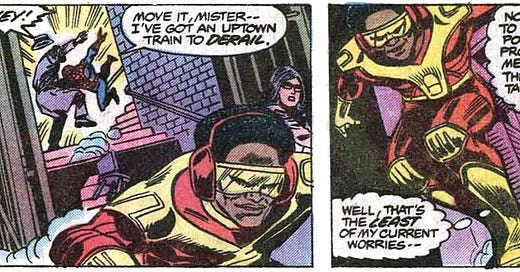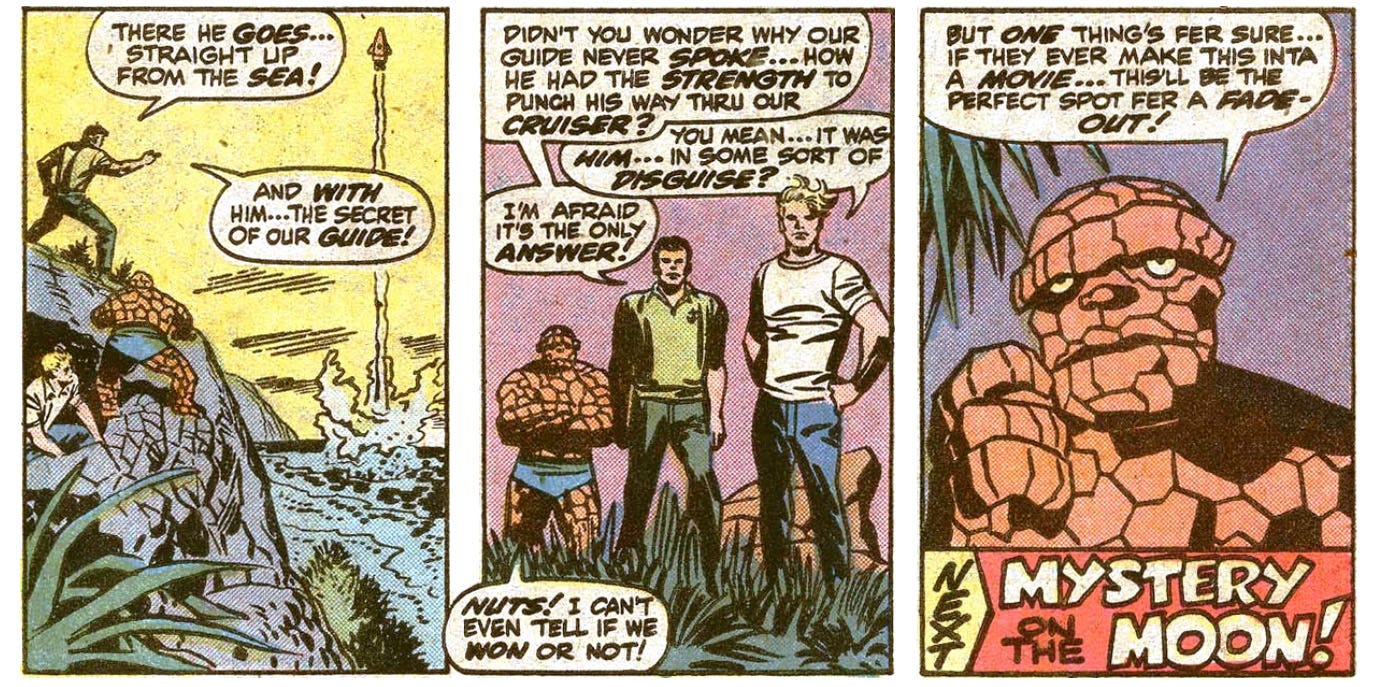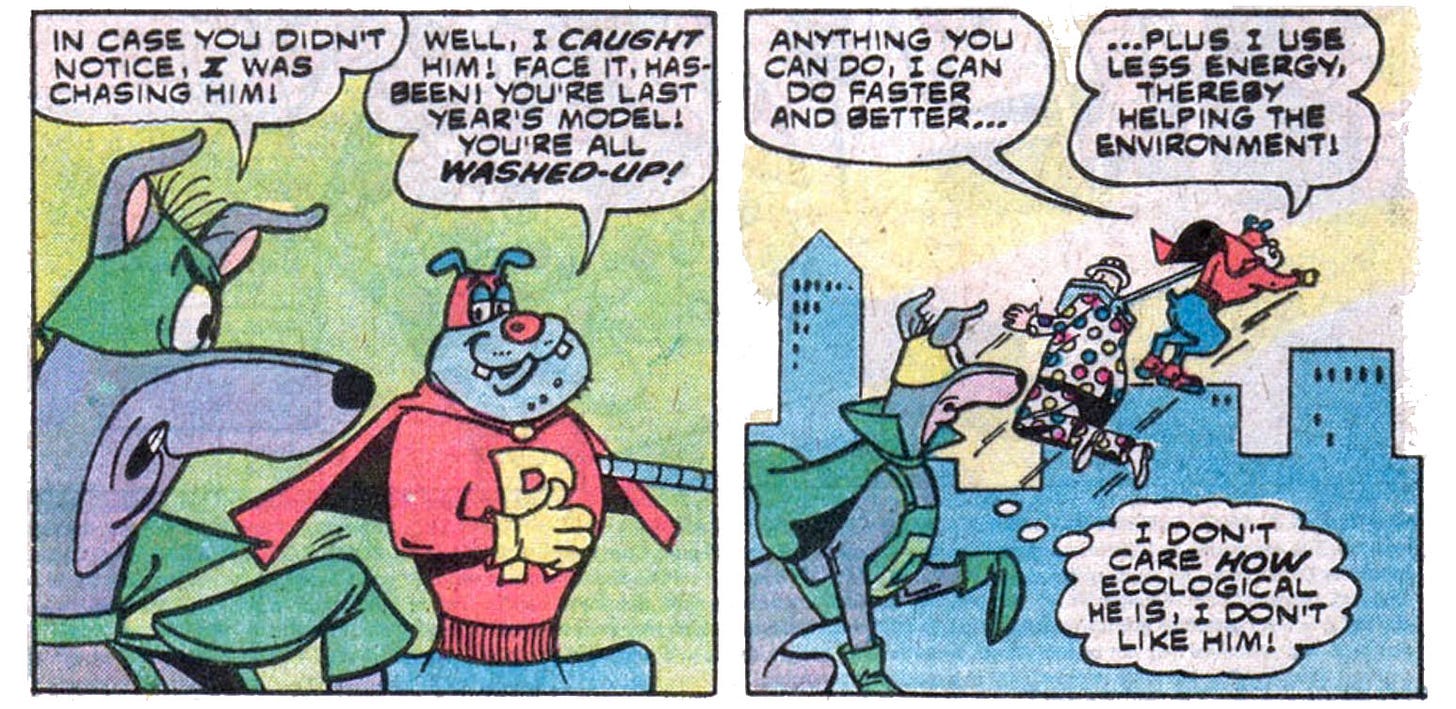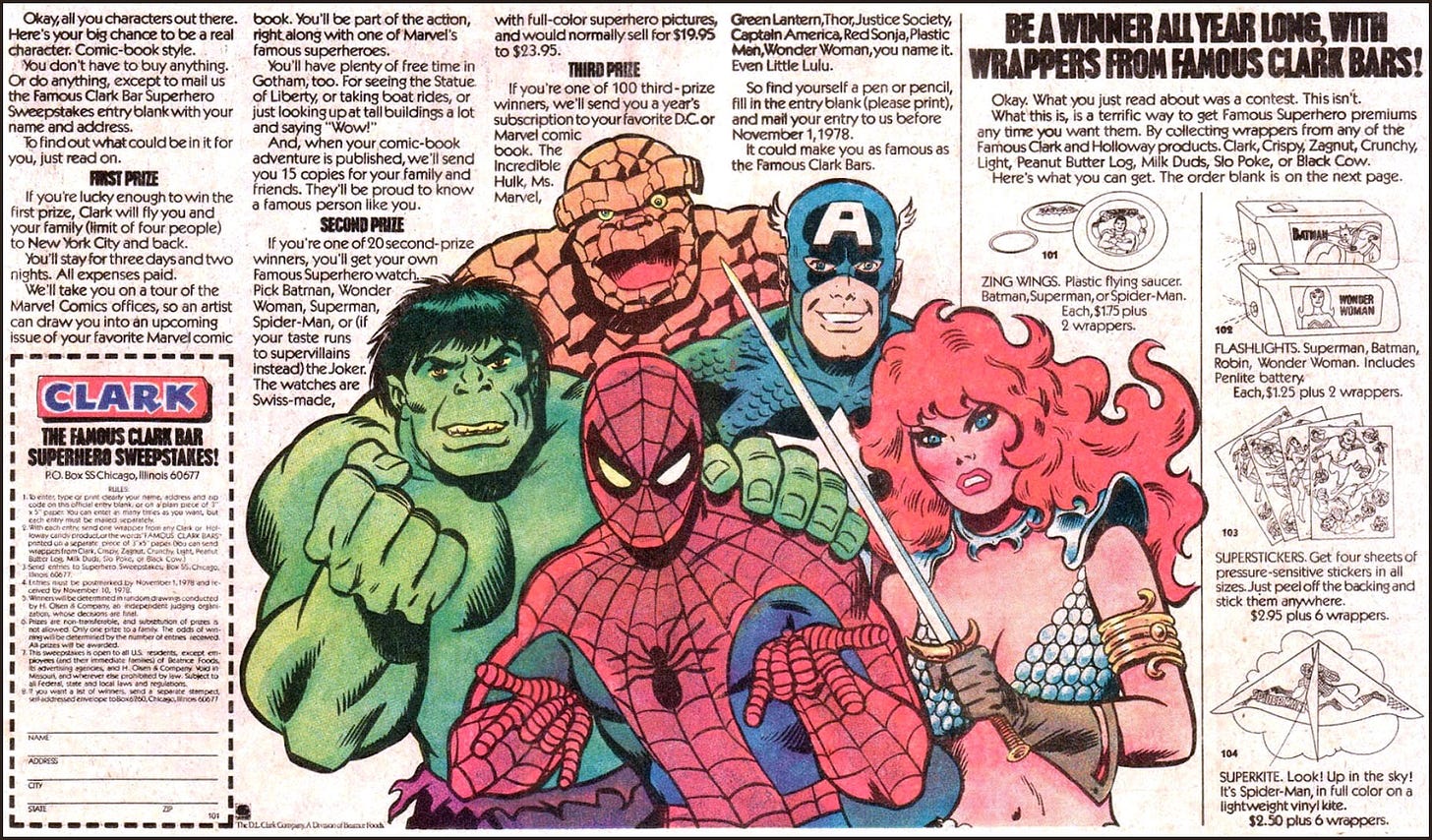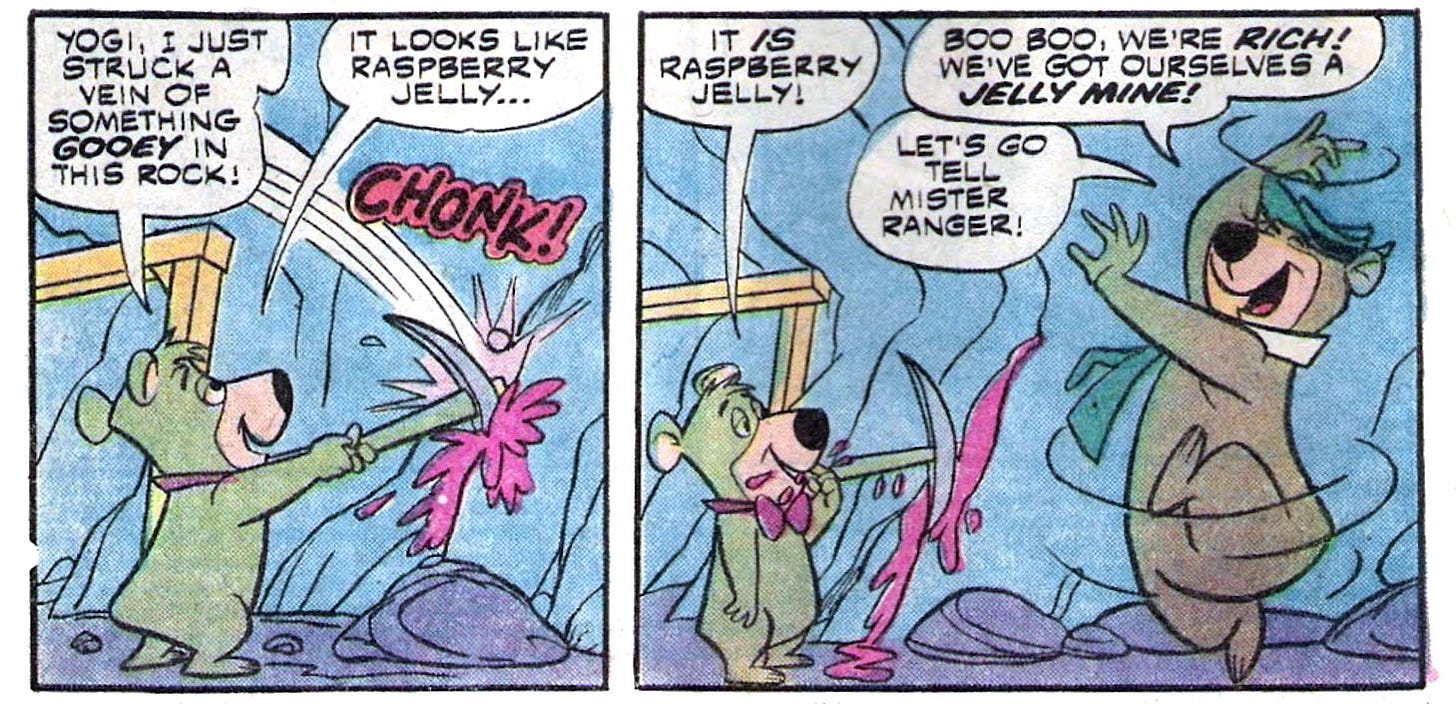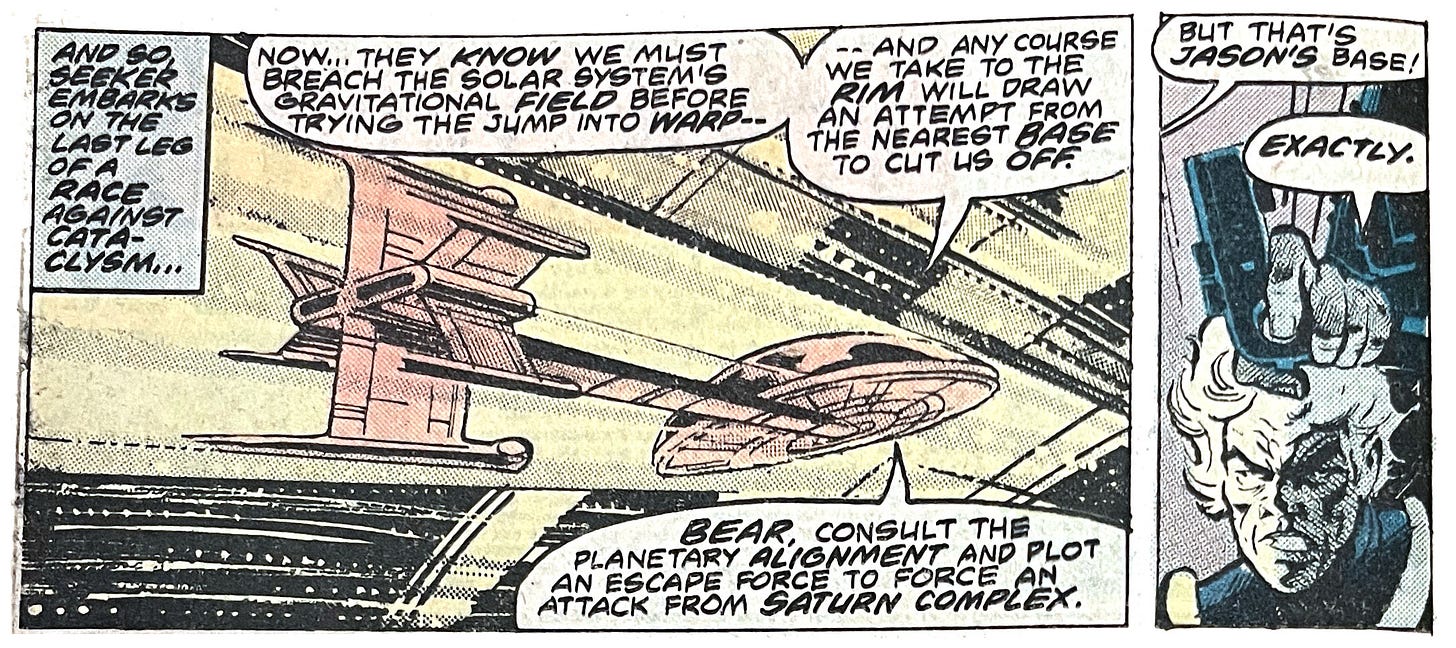Welcome to the one hundredth Marvel Time Warp post! In celebration of this milestone, this is going to be a big post, covering four Marvel books from the second week of April 1978 (they’re all 35-cent books released on April 11). And I’ll also include a Marvel book from January ’78 and the week fifteen wrap-up.
But I’ll start with one of the April books, one of Marvel’s biggest titles of the era, The Amazing Spider-Man.
The Rocket Racer’s Back in Town!
Even with my eyesight not nearly as good as it was back in 1978, I still think the best way to read comic books, especially old Bronze Age comic books printed on cheap, pulpy paper, is in their original format. Digital reproductions have the advantage of being more portable (you can put hundreds if not thousands of digital books on your iPad or whatever), plus you can zoom in and crank up the screen brightness, two things that make reading easier when your eyesight isn’t as good as it was in 1978. But the look and feel of the pulp paper and the printing process they used for those books is impossible to fully capture digitally.
And unfortunately, publishers often don’t even try to capture that original look. Many digital reprints of old comics are basically the original black-and-white inked art and lettering with new digital colors. Even when the new colors stick close to the originals (and they don’t always do that), they just look more modern. Because, for better or worse, the old analog printing process greatly impacted color rendering.
Take Marvel Unlimited, for example. It’s a terrific service where you get access to more than 30,000 comic books for ten bucks/month. But all of the old books I’ve read on Unlimited are digitally recolored.
If I’m reading a digital copy of an old book, I much prefer actual scans of the original comic book pages. These scans are often unofficial and made by fans, so they are gray market at best. But I find them so much more enjoyable than digitally remastered reprints.
I mention all of this to say I’ve found some scans of 1970s Amazing Spider-Man books, and they look so much better than the versions available on Marvel Unlimited.
Amazing Spider-Man no. 182 features pencil art from Ross Andru, inked by Mike Esposito. Andru is the Spider-Man artist I grew up on, so I consider his Spidey definitive. Add in John Costanza’s top-tier lettering work and getting to see this issue in (a good scan of) its original pulpy glory, and this is a beautiful comic book.
After the previous fill-in issue, Marv Wolfman takes over writing/editing duties with this issue. I’ve mentioned him before — he was also writing Tomb of Dracula at this time, and I am a big fan of his New Teen Titans run over at DC in the ’80s.
How does Wolfman do with this first story of his Amazing run? Pretty good! He opens the story with a fight scene between Spider-Man and a colorful villain (Rocket Racer, who gets around on a jet-powered skateboard) that ends up in a subway tunnel (very New York). Then there’s plenty of the Peter Parker soap opera melodrama that’s so important to a good Spider-Man story. Peter’s Aunt May is in the hospital (again). And his grumpy boss (newspaper publisher J. Jonah Jameson) is distracted and oddly polite — wonder what’s going on there? Wolfman throws in a quick 1978 pop-culture reference (Starsky and Hutch!) during the Spidey/Rocket Racer rematch that wraps up the story.
Rocket Racer escapes Spidey again in the end, but the real cliffhanger happens post-chase. Peter goes to visit his girlfriend Mary Jane and... asks her to marry him! She just says “gulp!”
Like I said, pretty good!
The Monster From the Lost Lagoon!
There’s no way I could celebrate my one hundredth Time Warp post without playing a round of “Did I have this comic book as a kid?” Today’s contestant is Marvel’s Greatest Comics no. 78. I am 99% sure I had this one, and I am pretty sure I got it months (or years?) after it was originally published as part of a pre-bagged three-pack of comic books that they used to sell at department stores like K-Mart.
I’ve mentioned these three-packs before when writing about Marvel’s Star Wars book. I used to see three-packs of reprints of early issue of Star Wars everywhere, and I probably had multiple copies of those books because of the three-packs — as I recall, they were popular Christmas stocking stuffers and birthday party prizes.
If you’d like to read more about Marvel’s bagged, multi-book retail sets, there’s a pretty thorough article about them over at the wyman.info website.
I couldn’t find a digital copy of Marvel’s Greatest Comics no. 78 anywhere. But, as you might recall, Marvel’s Greatest was a Fantastic Four reprint book in 1978. Since this issue is a reprint of Fantastic Four no. 97 from 1970, I read that book instead.
This classic Stan Lee/Jack Kirby tale starts with the Fantastic Four investigating some ships that have gone missing in Lost Lagoon. Actually, it’s just three of the Four — Reed “Mr. Fantastic” Richards, Johnny “Human Torch” Storm, and Ben “The Thing” Grimm — doing the investigating. The fourth Fantastic, Sue (AKA the Invisible Woman, AKA Reed’s wife), is hanging out on the beach keeping an eye on her and Reed’s baby son, Franklin.
The Four are supposed to be on vacation, but I guess vacations are hard to come by for superheroes.
The twenty-page uncut version of this story features a classic Kirby mid-issue splash page. But I bet that was dropped (along with another page or two) for the Marvel’s Greatest Comics reprint, because Marvel books in 1978 contained more ads and less story than they did in 1970. Kirby’s dynamic artwork is complemented by lettering from Sam Rosen. I’m sure I’ve seen his work before, but for whatever reason I’m just noticing it with this book, and it’s great.
As you might guess from this story’s title (“The Monster From the Lost Lagoon!”), it’s kind of like someone dropped the Fantastic Four into a 1950s sci-fi movie. The plot is basically Creature From the Black Lagoon-meets-It Came From Outer Space. In other words, it’s right up my alley.
Even the ever-lovin’, blue-eyed Thing seems to get that the vibe of this story is ’50s sci-fi matinee. He comments in the last panel of the book, “If they ever make this inta a movie... this’ll be the perfect spot fer a fade-out!”
Washed-Up Super-Hero
In Dynomutt no. 5 (part of Marvel’s licensed Hanna-Barbera line of comics aimed at younger kids), Dynomutt finds out there’s a new crime-fighting mechanical canine (called Rover-Robot) in town. But Rover-Robot is secretly working for the devious Mr. Mastermind to embarrass Dynomutt and to eliminate Mr. Mastermind’s criminal competition.
I’ve written before how Marvel’s top two characters in 1978 (based on the number of books they were in and their appearances in house ads) were Spider-Man and the Thing. There’s a Clark candy bar superhero sweepstakes ad in this issue of Dynomutt, and it features five Marvel characters — Spidey and the Thing, plus Hulk, Captain America, and Red Sonja. I’m a big fan of Sonja’s 1970s book, but I would have expected to see the Invisible Woman or Ms. Marvel or Spider-Woman here. Given that Hulk and Cap were big enough stars at this time that they both had their own reprint books (Marvel Super-Heroes and Marvel Super Action, respectively), their appearance in the ad is no surprise.
Dynomutt and his crime-fighting partner Blue Falcon also help out a leprechaun in this issue (someone stole his gold). Plus there’s a two-page teaser story for the next issue of Marvel’s Scooby-Doo book.
You probably know that my favorite part of these Hanna-Barbera books is the one-page “Funtastic World of Hanna-Barbera” text feature in each issue. This one is called “Everyone Loves a Mystery,” and it lays out a brief history of Hanna-Barbera detective characters, including feline sleuth Snooper, Secret Squirrel, Inch High Private Eye, and, of course, Scooby-Doo.
The Jelly Jam
In Yogi Bear no. 5 (another of Marvel’s licensed Hanna-Barbara books), Yogi gets tired of stealing picnic baskets from Jellystone Park visitors. In an attempt to make some money so he can just buy a pizza whenever he gets hungry, Yogi and his bear pal Boo Boo start mining for gold in Jellystone. But instead of gold they strike jelly — raspberry jelly, specifically. And then they strike marmalade. And then they strike cherry, blueberry, strawberry, plum, and peach jelly. Before the bears can sell their jelly and get rich, they get sabotaged by the competition — the guy who runs the Mother Feldman’s Homemade Preserves company.
In the second Yogi story in this issue, he has to get his girlfriend Cindy a last-minute gift because he forgot her birthday. Which is, of course, a classic sitcom trope. I have a vague memory that Yogi had a girlfriend, but I forgot she was pink and her name was Cindy. And in the last Yogi story, Yogi and Boo Boo get mistaken for private eyes Snooper the cat and Blabber Mouse, which is a bit of a tie-in with the “Funtastic World of Hanna-Barbera” mystery column that appeared in this month’s Dynomutt as well as in this Yogi book.
Lastly, there’s a two-page teaser for the May 1978 issue of the Flintstones comic book.
January ’78 Catch-Up — Marvel Premiere no. 41
I started my Marvel Time Warp reading project with the books published in February of 1978, because that’s the month the first comic book I ever read (Amazing Spider-Man no. 180) was published.
In hindsight, I should have just started with January of 1978. Because February is so close to the start of the year. Now, I’m not going to start this whole project over. However, I am going to start jumping back and reading the books from January 1978. And I’ll probably write a little about them when I’m covering other books. So the January books will be kind of the “B” story for some Marvel Time Warp posts.
I chose the January 1978 issue of Marvel Premiere for my first “catch-up” book for a couple of reasons: (1) Premiere is an anthology book, and issue no. 41 is a stand-alone story; and (2) I actually found an original copy of this issue at a comics shop a few months ago — bonus, it was in the dollar bin, so I got it cheap!
The story here, “The Dying Sun,” is about the maiden voyage of a large spaceship, Seeker 3000. It’s set sometime in the future, and earth’s sun is about to go nova. So a few hundred folks board the Seeker in hopes of getting out of the solar system before it all blows up.
There’s a lot of story in here — the creative team, led by Doug Moench and Tom Sutton, basically cram enough story for a feature-length sci-fi flick (or a two-hour TV pilot) into eighteen comic book pages. The design of the Seeker, with its big saucer section up front, recalls the Enterprise from Star Trek, but the vibe here feels more Space: 1999 to me. Which makes sense — Trek is all 1960s optimism, and Seeker 3000 and Space: 1999 are both products of the more cynical 1970s.
I didn’t see anything particularly groundbreaking in the Seeker 3000 story, but I would be happy to read more stories about this ship and its crew. Not that I’m expecting Marvel to revive Seeker 3000 anytime soon. But hey, you never know.
Marvel was at least somewhat supportive of this book back in the day. The editorial staff gave it a paragraph in the “Bullpen Bulletins” feature that ran in all of Marvel’s comic books in January of ’78.
Week Fifteen Wrap-Up
Not counting their UK reprint books (The Complete Fantastic Four no. 29, Rampage no. 26, and Star Wars Weekly no. 10), Marvel published nine 35-cent books in the second week of April 1978. Total cover price for all of these books was $3.15. Adjusted for 2022 inflation, that’d be about fourteen bucks.
Next time — On to week sixteen of 1978!
